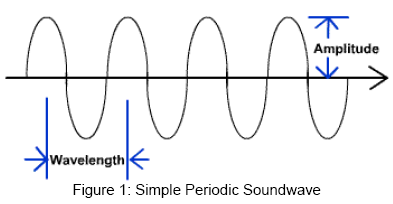It is prerequisite in order to conduct a successful acoustic analysis to know the basic facts in acoustic and phonetic science. The fundamental principle of acoustics is that sound propagates through space as waves. The sound-waves expand through air as disturbances in the surrounding pressure level. As the sound expands the molecules start to move back and forth changing the pressure in different positions within the air. Where many molecules are pushed together compression occurs, where the molecules are more widely spread there is dilation.
In other words, although each individual molecule merely oscillates in its own place, energy is passed on and on from one molecule to the next, and consequently a wave of alternate compression and dilation spreads steadily outward from the source. (Catford 1977: 48)
So basically, a sound can be described as “(..) a series of rapidly expanding concentric spheres of alternate compression and dilation, radiating from the source.” (Catford 1977: 48). The changing levels of compression and dilation form a wave. An oscilloscope can visualize the movement of the molecules. Where the pressure is high the curve moves up, where the pressure is low it moves down. In one single oscillation the curve will go from zero pressure to maximum, back down to zero, to minimum and back to zero again. The completion of this process is called a cycle. It is also the wavelength. The number of cycles completed in one second is called frequency and is measured in Hertz (Hz). The human ear conceives the frequency as pitch. The smaller the frequency, the lower the pitch. It is said that younger people can perceive a frequency range from about 20 to 20,000 Hz, although, in order to perceive “normal” human speech a range from 50Hz to 8000Hz suffices (Catford 1977: 48).
The loudness or intensity of a sound is called sound pressure level and is measured in decibel and pascal. An oscilloscope represents the loudness as the maximum and minimum of the amplitude.

There are three different kinds of sound waves. There are simple periodic waves which can be provided by a tuning fork or other instruments when playing just one tone. These waves are artificial. No naturally produced sound would have a simple periodic wave-form.
The second kind of waves are complex periodic waves. A complex periodic wave consists of at least two superimposed waves with different frequencies. This means that there are several other tones, so called harmonics, which through simultaneous vibration create a sound's quality.

The third kind of wave is the aperiodic wave. These waves, which can also be called nonrepetitive waves, represent short sounds. They do not produce a periodic wave which repeats itself for the length of the sound, but create maybe one oscillation. Aperiodic sound waves can also be referred to as noise (Reetz 2003; Catford 1977).

Created with the Personal Edition of HelpNDoc: Full-featured EPub generator